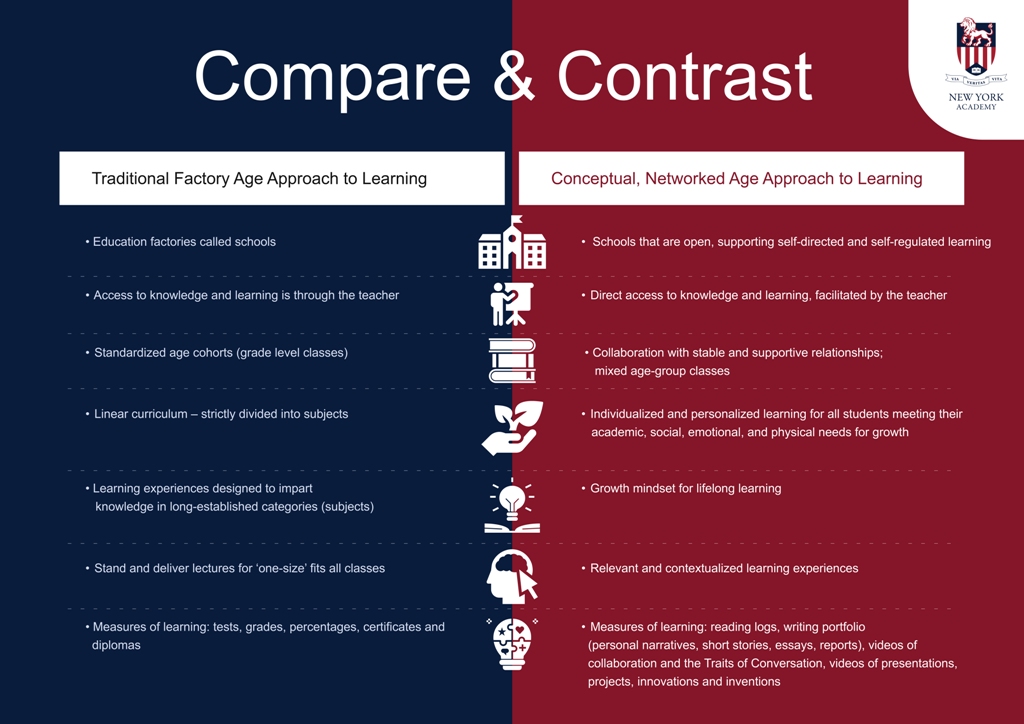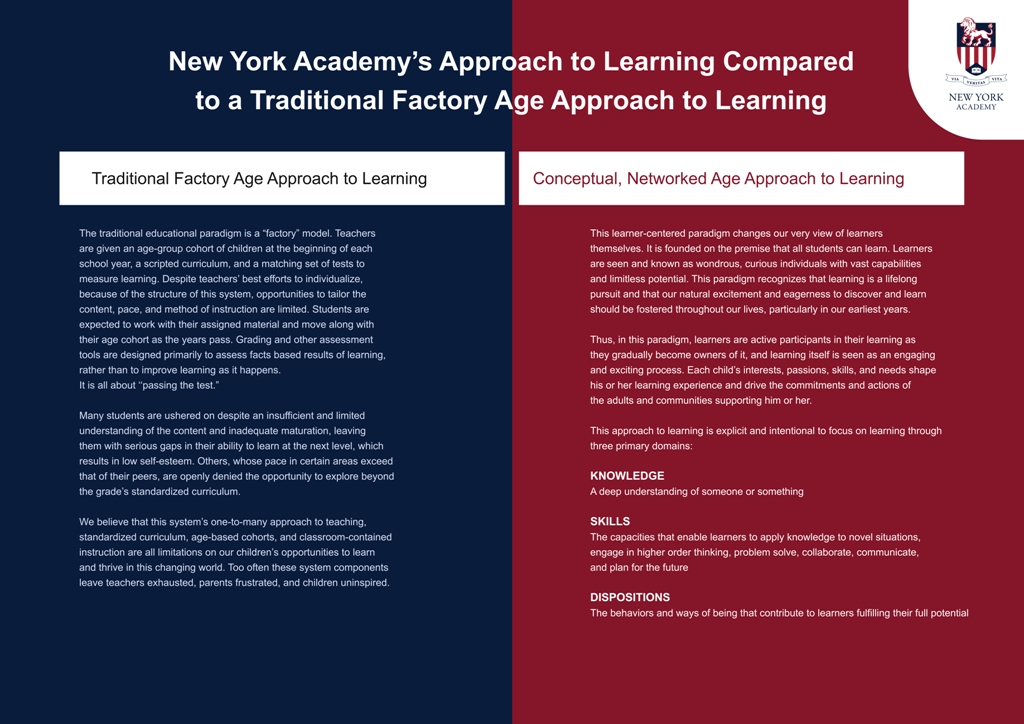Curriculum
Introduction
At New York Academy we prepare students to be members of our global society. In this way, it is our responsibility to not just teach them to memorize facts and figures, but to think deeply, ask questions, and care for their friends, family and world. Of course our students do learn important facts and figures in language arts, math, science, and more, but they learn how to engage with the content and apply it to their lives while they do so.
We accomplish these goals through a multi-faceted approach to learning. We have developed Schoolwide Learner Outcomes that all teachers help their students strive toward. We follow the AERO standards, which are approved by the U.S. State Department’s Office of Overseas Schools, and provide a framework for us to work from. We utilize internationally-recognized summative and formative assessments. And we get to know each student as an individual so that our curriculum and instruction can help guide them to think deeply, question thoughtfully, and reach their goals.
Learning at New York Academy is about more than writing in workbooks and memorizing facts. It is about engaging each student in learning and teaching them skills that have lasting value beyond the classroom.
Enduring understandings are statements summarizing important ideas and core processes that are central to a discipline. This knowledge has value outside the classroom and is something students will draw from again and again in their lives. These statements synthesize what students should understand—not just know or do—as a result of studying a particular content area. Enduring understandings are transferable and teach students to apply their knowledge to their lives rather than being forgettable facts and figures. They are big ideas that can be applied in a variety of ways to solve problems.
Essential questions require students to think deeply and process what they have learned. They cannot be answered with finality in a single lesson or a brief sentence, and definitely not with a simple yes or no—and that's the point. Their aim is to stimulate thought, to provoke inquiry, and to spark more questions, including thoughtful student questions, not just pat answers. They are provocative and generative. They stimulate excitement in our students and engage them in the content they are learning. In this way our students begin to drive their own learning in a way that doesn’t stop when they leave school at the end of they day. Don’t be surprised if your student comes home with thoughtful questions for you!
At New York Academy, we teach our students how to develop critical thinking skills so that they learn to innovate and solve problems rather than just memorize facts. Students are taught to think deeply about what they learn, ask questions, and seek out answers.
There are 11 Cognitive Processes that are the fundamentals of critical thinking:
- Activate and Connect Background Knowledge
- Visualize
- Generate Questions
- Make Inferences
- Gain Perspective and Empathy
- Compare and Contrast
- Identify Cause and Effect
- Conclude and Predict
- Analyze and Synthesize
- Determine Importance
- Monitor Comprehension
A large part of critical thinking is the Design Thinking Process. We believe students should be actively engaged in their learning. Rather than always follow a prescribed course of study, we let them take the reins and innovate to solve problems they have identified. Design Thinking is an innovative methodology that gives students the chance to explore, learn and cultivate their curiosity.
Design Thinking has evolved over time from Theme-Based Projects and Project-Based Learning. All three of these approaches aim to engage students in learning to give them ownership and to create with purpose. Over the past several years, the Design Thinking Process has taken hold and continues to evolve as the premier way for students to learn through inquiry.
Where Project-Based Learning is widely teacher driven, Design Thinking puts the student at the center. The Design Thinking Process, or Maker Learning, aims to have students invent by creating innovative solutions to problems. Students are guided to explore dozens of potential lines of teacher-provided inquiry, and eventually to identify those lines of inquiry on their own. The teacher facilitates, models, guides and coaches. The students drive the process. What makes it groundbreaking is that it helps students learn to innovate, create, and solve problems. This will be a critically important skill set as we enter the Creative Age.
Design Thinking ProcessThe Design Thinking Process may be defined as:
Empathize > Define > Ideate > Prototype > Test EmpathizeBefore any work can begin on a project, students must gain an empathic understanding of the problem they are trying to solve. They may talk to experts and immerse themselves in the problem. The goal of this first step is to gain insight into the needs of the end-user.
DefineOnly after students fully understand the problem can it be defined. Students gather all their information and synthesize it into one cohesive problem to solve. They learn to express the problem in a way that is human centered so that their inquiry is always driven by empathy and human need.
IdeateThis is where our students’ creativity really shines! Students think outside the box to generate a multitude of ideas that may help solve the problem they have identified
PrototypeThis is the experimental phase of the process. Students utilize our Maker Space to design and build their solutions.
TestAfter completing the prototype, students must test it to see how well it solves their problem. The process is not always linear, as the test might help students redefine their question or lead to changes that require them to return to the prototype phase. Students are always thinking and reevaluating to see how they can better solve the problem they have identified.
AERO is a project supported by the U.S. State Department’s Office of Overseas Schools and the Overseas Schools Advisory Council to assist schools in developing and implementing standards-based curricula. AERO provides a framework for curriculum consistency across grades K-12 and for stability of curriculum in overseas schools. This effort is in alignment with research-based trends in the development of curriculum worldwide, and particularly with the Common Core initiative in the U.S.
New York Academy has strategically chosen to adopt the AERO Standards because they provide a standards-based framework with the flexibility that allows us to innovate and create solutions tailor-made for our school community here in Hyderabad. The AERO Standards are a robust set of learning outcomes for all subjects with high expectations for academic achievement.
The New York Academy curriculum, across all subjects, makes learning outcomes for each lesson explicit and intentional with Learning Points. These are statements of what a student is to know (knowledge), understand (concepts), and able to do (skills). If you walk into any classroom at NYA, you will see the LP written on the board for the current lesson. Our Learning Points are crafted from the AERO Standards, but written in student friendly terms:
EXAMPLE LP: Readers make meaning by thinking about the character’s desires and struggles across the events of the story (reading comprehension).
At New York Academy, we utilize both formative and summative assessments. These assessments are designs to ensure that instruction is differentiated to meet the academic needs of each individual student. Our assessments include:
- Phonological Awareness Skills Test – PAST (formative)
- Development Spelling Inventory – DSI (formative)
- Developmental Reading Assessment 2 – DRA2 (formative)
- 6 Traits of Writing/Small Moments Scene with Narrative Prompt (formative)
- 4 Traits of Presentation (formative)
- Basic Numeracy and Problem Solving (formative)
- ERB (summative)
Formative assessments are given throughout a unit of study and used to gauge student learning, drive instruction, and increase student performance. Teachers are able to respond to students needs quickly and accurately by continually measuring their learning. A student’s Zone of Proximal Development (ZPD) is determined – the area of thinking or action that a child is unable to do independently but can do successfully with the assistance of a skilled person (Vygotsky, 1978).
Formative assessments provide data on a regular basis to the teacher to employ best practices per the differentiated needs of each student in word study, reading fluency, reading comprehension, critical thinking, writing, and numeracy. As a result, instruction and learning are fluid and can change in accordance with each student’s needs. The formative assessments employed by NYA are used at the start of the year to gain a baseline of academic achievement and at the end of the year to measure growth. They are also used throughout the year to individualize instruction and meet the needs of each student.
Summative AssessmentsSummative Assessments are used to evaluate student learning at the end of a unit of study and the end of school year and measure overall growth. They help teachers and the school analyze and reflect upon the strength of our curriculum and learning program.
At New York Academy, we utilize the ERB Comprehensive Testing Program (CTP) as an end-of-year assessment. The CTP is a rigorous assessment for high achieving students in areas such as reading, listening, vocabulary, writing, science and mathematics.
Many international parents are concerned about how to measure their child’s learning against peers in the United States. The CTP, which is a nationally norm-referenced summative assessment, allows NYA to do just this. Verbal and quantitative reasoning subtests are part of the CTP beginning in Grade 3.


